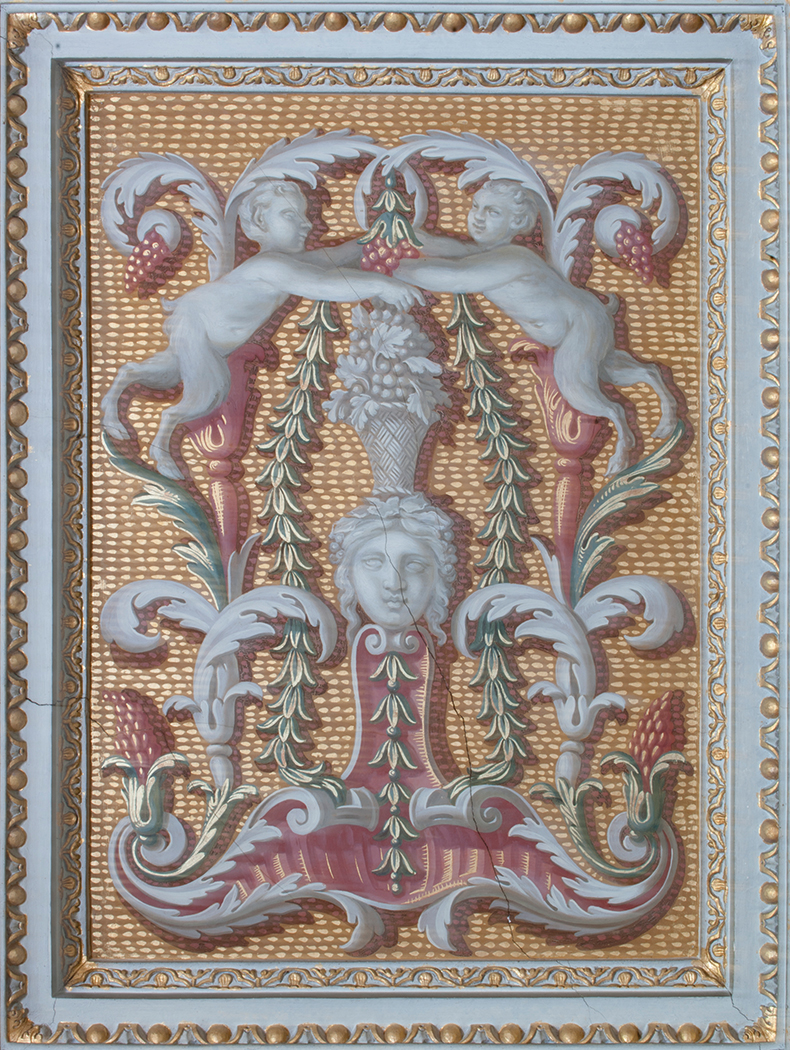From the June 2022 issue of Apollo. Preview and subscribe here.
The Green Velvet Drawing Room, like the ceiling of the preceding room, The Saloon, has an octagon at the centre of its rectangular ceiling, though on an appropriately smaller scale. Inside, Venus sits on the edge of her scallop shell, her left hand clutching its edge as she prepares to descend, her right hand holding up a string of pearls. She is quite naked, as if she has just emerged, fully grown, from the sea where she was born. In each corner of the rectangle, she is surrounded by deities representing the four elements: Apollo for fire, Cybele for earth, Neptune for water, Juno for air. All are in their chariots, being pulled along towards Venus: Apollo by his horses, Cybele by her lions, Neptune by a pair of hippocamps, Juno by her peacocks. They carry them with attributes to offer to the newly born goddess of love: Apollo, a sunflower; Cybele, a cornucopia; Neptune, a conch; and Juno, a peachick. Separating these deities are four rectangles, each with a pair of little Pans and a decorative mask surmounted by a woven basket. The two end rectangles have further small panels below them, with swans either side of a mask. Every segment has a background of ochre fictive mosaic, as in the Saloon, but in contrast, here the subjects are surrounded by prominent foliate motifs: one pattern being uniform to the four corner panels, another to the four rectangular panels, a third to the two small end panels, while the central octagon has its own display.
Stylistically, the ceiling’s segmentation can be traced through the Renaissance borrowings to the ceilings of antique buildings that had been discovered in Rome, such as the Domus Aurea, or Hadrian’s Villa in Tivoli. However, the pattern of the Drawing Room’s ceiling is in fact exactly the same (though adjusted from a square to a rectangle) as the one Veronese had used soon after 1560 for the Sala dell’Olimpo in Palladio’s Villa Barbaro at Maser. Kent did not visit Maser on his tour of north Italy in 1714 but exactly one hundred years earlier, Inigo Jones had been there – as proved by the annotations in his 1601 copy of Palladio’s I quattro libri dell’ architettura, where he had noted ‘a great commodity of waater to roun from on part to another for several youses.’ Inigo Jones had clearly used Veronese’s design, probably between 1635 and 1638, at the Queen’s House at Greenwich, where it is repeated on the ceiling of the original Cabinet Room – the first-floor room at the northeast corner of the house, ‘behind the round stairs’ – although in contrast to the Villa Barbaro, the Cabinet Room’s ceiling was left undecorated.
William Kent’s gilded Venus adorning the ceiling of the Green Velvet Drawing Room at Houghton Hall, Norfolk. Photo: Tim Smith

Kent uses a pale brown to model figures and steeds, as well as the other attributes that reinforce identities: the edge of Venus’s shell, the pearls hanging down to lap her arm, the two doves that perch above her; Neptune’s trident and conche; the peachick in Juno’s hands; Cybele’s cornucopia; and Apollo’s sunflower, which, as god of music as well as the sun, he holds like a tambourine (perhaps another instance of Kentian wit, since in classical iconography tambourines were typically associated with maenads, followers of Bacchus). The pale brown also models Robert Walpole’s cherished garter star, placed around the central chandelier’s anchor, and so discreetly overlapping Venus’s thigh. A sombre green, in its deep tones close to the velvet with which the room was originally hung, is used to line Venus’s shell, at one side flecked with pale yellow bands of highlights to emphasise the shell’s crenations. It also provides dolphins swirling below the goddess to remind us of her marine genesis, and playing on either side of Neptune as part of his realm. It adds lyres to Apollo’s corner (a more familiar attribute than the sunflower), woven baskets filled with fruit to Cybele’s, and four more fluttering peachicks to Juno’s.
Images of Cybele and Neptune had first been introduced in the Saloon as signifiers of Walpole’s stewardship. And the four rectangles that serve to separate the corner panels of the elements also reprise a theme from the Saloon: that of the four seasons. In the Drawing Room the mask of a young girl with plaits has a basket of flowers for spring; a slightly older woman with loose hair has a basket of summer wheat; a plump-cheeked male with vine leaves and grapes in his hair has an autumnal basket of grapes; and an old man’s mask with hollow cheeks, a droopy moustache and a straggly beard has root vegetables, probably parsnips and turnips, signifying winter. It is a concise way of uniting the motifs from the Saloon’s ceiling and cove so as to complement the Drawing Room’s tetradic theme, while the repeated green bellflower chains and dusky red calyces that rise or hang in the corners link the displays of masks and Pans to the panels of gods and goddesses they abut. By way of a coda, the two small trapezoidal end panels are each dominated by the pair of swans who would draw Venus’s chariot – holding snakes in their bills, they flank a diminutive mask set against a dark green scallop shell, echoing the ceiling’s central octagon. In another instance of Kent’s integrative approach, the swan’s reappear in the second of the series of four Venus and Adonis tapestries commissioned by Walpole for the adjacent Green Velvet Bedchamber, where Venus’s arrival is based on a painting by Rubens. Together, the ceiling’s many layers of reference form an intricate and rich iconographic programme, showing just how much Kent had absorbed during his time in Italy.
A detail of one of the rectangles separating the four deities, featuring a pair of Pans. Photo: Tim Smith

The Green Velvet Drawing Room makes a clear statement that the run of rooms will continue to be dominated by antique deities (if in the Marble Parlour a deity represented by a putto). It introduces, via Inigo Jones, a direct echo of a Palladian masterpiece. And through the mise en scène of Venus and the modelling of the sculptural groups that surround her, together with its colours and its authentically Roman foliate scrolls, it makes a direct reference to the antique itself, rather than to Renaissance or baroque reimaginings of the antique – in its own way perhaps every bit as potent a reminder of the grandeur that was Rome as is provided by the reliefs and busts of the Stone Hall.
This is an edited extract from William Kent’s Ceiling Paintings at Houghton Hall, published by The Houghton Arts Foundation.
From the June 2022 issue of Apollo. Preview and subscribe here.


